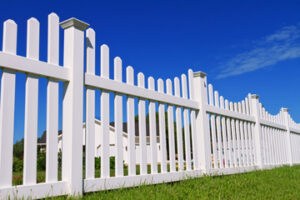How to Install a Vinyl Fence
Vinyl Fence In NJ comes in a variety of styles and colors. They can be used to keep pets and children safe or enhance property security. They also provide privacy and add curb appeal to a home.
Surface dirt and mildew can be cleaned with periodic spraying from a garden hose. For more stubborn stains, baking soda, and dish soap work well.
The cost of a vinyl fence can vary widely depending on where you live. You may pay less if you are in a rural town, but it will be more if you live in a major city. Local prices can also vary due to factors such as the cost of labor and material costs. If you plan to install your vinyl fence yourself, you can save money by following the installation instructions provided with the product. This will help you estimate the materials you need and locate post-center measurements.
It is important to prepare your yard before beginning a vinyl fence project. Use landscape stakes to mark the boundary line around the area where you will install the fence, and mark the location of each end, corner and gate post. This will allow you to make sure your fence is built to code, and that it is as square as possible. You can also use a level to ensure that your fence posts are plumb. Finally, be sure to leave a small gap between the fence and your property. This will help you prevent damage to your property and ensure that the vinyl can expand and contract as it adjusts to weather conditions.
Another important step in preparation is to call your local “Call Before You Dig” line. This will let you know if there are any underground utility lines in your yard. If you hit a line while digging, it can cause serious injury or even death. The good news is that most utility companies will come out and mark the location of any lines that are in your yard.
Once the installation of your vinyl fence is complete, it is a good idea to add some finishing touches to give it a custom look. You can add a gate, locks, and other decorative features that will make your yard more secure and attractive. Another way to customize your vinyl fence is to have it painted. This will protect it from the elements and keep it looking beautiful.
Another advantage of vinyl fencing is that it requires little maintenance. While it can be expensive to replace wood fences, the initial investment will save you time and money in the long run. Vinyl is extremely durable and will last for decades if properly cared for. It is easy to clean, resists stains and scratches, and won’t rot or mold.
Durability
A vinyl fence is a great way to add privacy and security to your property. It also has a long lifespan, and unlike wood fencing, it will not warp or rot. However, installing a vinyl fence is not as simple as putting up a wooden fence. It requires special tools and knowledge to ensure that the fence is secure. You should also be prepared to spend a few extra dollars on your materials. Choosing the right contractor is also essential, as they will be responsible for the entire installation process.
Homeowners who try to save money by doing the work themselves will often end up with a poorly constructed and less durable fence. This is because they are often not experienced at measuring the exact lines, digging post holes, and pouring concrete. Even if they do manage to set their posts at the precise size, it is unlikely that they will be able to make them perfectly level. It is important to take your time and carefully follow the instructions for each step of the installation process.
Once your foundation is in place, you can begin to install the rails and panels. You should leave a small gap between the rails and the posts, which will allow for expansion and contraction of the vinyl. This will help to prevent the fence from sagging in windy conditions. It is also important to call your local “Call Before You Dig” line before beginning any digging to make sure you are not working near any underground utility lines.
Another way to improve the durability of your vinyl fence is to choose a color that will blend in with the surrounding environment. You can also pay more to get decorative features like lights on the posts or crisscross patterns in the fence panels. These features will increase the cost of your vinyl fence, but they will be well worth it in the long run.
To keep your vinyl fence looking its best, you should wash it off regularly with a garden hose. Regular cleaning will remove any dirt and mold, which can cause the vinyl to become discolored. You should also plan a schedule for regular maintenance inspections so that you can identify and repair any damage as soon as it occurs.
Maintenance
A beautiful vinyl fence says a lot about the homeowners that live behind it. Not only does it show off their impeccable taste, but it also shows they have a strong financial sense. These reasons have made vinyl a popular choice among St. Louis home owners for fencing their yards. It’s easy to see why. Vinyl is a durable, low-maintenance material that will add value to your home and last for years. It is also resistant to stains, mold, and mildew. It is not susceptible to wood-rot or insects, which makes it a smart and economical option.
A vinyl fence requires little maintenance to maintain a clean and fresh look. Surface dirt can be easily removed with a periodic hose-down with a non-abrasive cleaning solution. The same cleaning solution can be used to remove tough stains. Mildew and mold can cause the vinyl to look splotchy or weaken it. Cleaning it regularly is the best way to prevent this.
Vinyl fencing is more durable than many other types of fences and can hold up well in harsh weather conditions. It is almost five times stronger than wood, which means that it can resist dents and scrapes better. However, a regular inspection is necessary to spot any damage and make repairs immediately.
During an inspection, check for signs of rust or loosening of parts. If you see any, then re-tighten them using a screwdriver or wrench. You should also check the connections between posts and rails. Most vinyl fences use hidden metal connectors, but these can sometimes become loose or break. Ideally, the connectors should be tightened with the help of a wrench or screwdriver.
It’s important to keep your yard free of overhanging branches or plants near a vinyl fence. During a storm, these branches may fall on the fence and cause damage. Overgrown weeds can also be a problem for a vinyl fence. If you hire a lawn care company, be sure to warn them to avoid cutting the grass or weeds too close to your fence.
A run-down and shabby-looking vinyl fence can detract from your home’s appearance, and it can even be an invitation for burglars to enter. It’s a good idea to have a professional clean and repair your vinyl fence on a regular basis. This will ensure that it stays looking new and protects your property.
Environmentally friendly
Vinyl fencing is an attractive choice for many homeowners because it requires minimal maintenance, and it can be used for security or to provide privacy. It is also durable, versatile, and aesthetically pleasing. However, some people are concerned about the environmental impact of vinyl fences. This is because they are not made from a natural material and they are produced using chemicals that pollute the environment. Fortunately, new advancements in production and recycling processes are making these products more environmentally friendly.
Another consideration when choosing a fence for your property is how it will hold up to extreme temperature changes. Many homeowners assume that their fence will be damaged when exposed to sudden changes in weather, but high-quality vinyl can withstand these fluctuations without any issues. In addition, it will not be infested by termites or warp or sag like wood fences.
A vinyl fence is made from polyvinyl chloride (PVC), which is a synthetic plastic that is highly durable and resistant to the elements. While it is not a natural material, PVC can be recycled after its lifespan. This can help reduce the amount of waste that ends up in landfills. However, it is important to note that the manufacturing process of PVC involves the use of a number of resources, including natural gas and salt. This can cause significant environmental impacts.
Despite the negative effects of PVC, there are ways to make vinyl fences more environmentally friendly. For instance, homeowners can buy PVC with a low percentage of chlorine and use it in places that require chlorine-free water. Additionally, they can purchase a high-quality vinyl that is formulated with Titanium Dioxide to protect it from UV rays.
Unlike some other fencing materials, vinyl is easy to install. Homeowners can do it themselves or have a professional do the work. Installation takes less time and is much easier than constructing a traditional wooden or metal fence. There are no boards to cut and no need for painting or staining. In fact, a well-maintained vinyl fence can last for decades.






